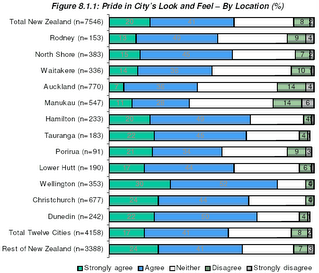Reading between the headlines
As some of my readers have pointed out to me, there have been a few public announcements recently that may not be entirely what they seem.
The release of the Big Cities Quality of Life Survey was the occasion for a very self-congratulatory media release from Wellington City Council, headed "Wellington Simply the Best, Survey Reveals". Wellingtonians certainly do seem to be relatively happy with their city, but some of the comparisons are fairly meaningless. For example, "Wellington ranks highest among the cities in terms of people feeling safe in their homes during the day (99%) and at night (96%)", but the difference is so minimal as to be laughable: Christchurch achieves 98% and 96% respectively. Some of the results are indeed worth crowing about, such as definitely having a city that looks and feels good to us:
 That graph comes from page of the very comprehensive full report (11.4MB PDF), which is definitely worth reading if you want to get past the spin from the various interested parties. As another example, according to the press release: "One area of concern highlighted in the survey is graffiti, with 58% of Wellingtonians interviewed considering it to be a problem, up from 42% in 2004. Mayor Prendergast says the Council plans to tackle this problem by funding a 'flying squad' to clean up graffiti quickly." You can just imagine the hordes of taggers and street artists yelling "Leg it, it's the Sweeney!". But as the report shows (page 295), Wellington has almost the lowest level of concern about graffiti, just above North Shore and Lower Hutt on 56%, and much less than the cross-city average of 70%. Hey! Council! Leave our stencils alone!
That graph comes from page of the very comprehensive full report (11.4MB PDF), which is definitely worth reading if you want to get past the spin from the various interested parties. As another example, according to the press release: "One area of concern highlighted in the survey is graffiti, with 58% of Wellingtonians interviewed considering it to be a problem, up from 42% in 2004. Mayor Prendergast says the Council plans to tackle this problem by funding a 'flying squad' to clean up graffiti quickly." You can just imagine the hordes of taggers and street artists yelling "Leg it, it's the Sweeney!". But as the report shows (page 295), Wellington has almost the lowest level of concern about graffiti, just above North Shore and Lower Hutt on 56%, and much less than the cross-city average of 70%. Hey! Council! Leave our stencils alone!...
The coverage of funding for social housing may not have been exactly misleading, but a casual observer might have gained the impression that this would be new investment in increasing housing stock, rather than patching up the existing flats to make them actually suitable for human beings. The council appears quite munificent at first, until you realise that some councillors had been pushing hard to sell off the social housing, and then one starts to wonder whether the whole thing might be more about the government giving in to council blackmail: "pay up, or the flats get it".
As it turns out, some of the buildings may not be just upgraded but demolished and rebuilt. Hmm, I wonder whether they might run into heritage issues with that: what if the Arlington apartments in Mt Cook get listed as a notable example of early Ath? And if they do they do rebuild, let's hope that some of it is done as high-density medium-rise buildings along real public streets, not cheap & nasty towers set in useless and alienating "estates".
...
Finally, I'm trying to work out just what this media release from the regional council actually means. "GW to invest in regional flood protection & public transport" - sounds great! So does the news that they're trying to respond to "the strong messages received through our community consultation processes for a greater investment to be made on flood protection measures and also on regional public transport". So how much new investment is going towards public transport? There's a table further on that shows transport rates increasing from $32.8m in 06/07 to $35.9m in 07/08: a rise of 9.4%. But that's only a $3m increase, which is peanuts in this context, and while this does seem to be an increase on what was previously planned, will it actually be new investment?
Another part of the release, clearly aimed more at mollifying ratepayers than improving public transport, states that "if recent diesel prices increases are overlooked, the planned investment increase in regional transport is also less than the current rate of inflation." If that means what I think it means, they're not even keeping up with running costs, let alone making "greater investment" in public transport. I'll be quite happy to be proved wrong, but at the moment that looks like a very misleading headline, and the regional council is still persisting with its tired old "roads first" policy.
...
 And finally, not picking on the councils for a change, how about these apartments being advertised for sale? Yes, they're in the very same god-awful twin lumps that I've been pleased to announce have not been given consent and probably never will. The agents are confidently telling prospective buyers that construction will start in July this year, and that there will be no risks involved in getting consent, and according to their site they've already sold 60 of the 228 studio apartments. Not only is this an appallingly unimaginative design, but it's a non-complying activity and as I've recently double-checked, the council's planners and urban designers are against it. The urban design team does actually get a say in developments that breach the district plan, and going around selling these non-existing apartments when there is no approval is hardly going to endear them to the council. Mind you, the property company involved does have a bit of a reputation.
And finally, not picking on the councils for a change, how about these apartments being advertised for sale? Yes, they're in the very same god-awful twin lumps that I've been pleased to announce have not been given consent and probably never will. The agents are confidently telling prospective buyers that construction will start in July this year, and that there will be no risks involved in getting consent, and according to their site they've already sold 60 of the 228 studio apartments. Not only is this an appallingly unimaginative design, but it's a non-complying activity and as I've recently double-checked, the council's planners and urban designers are against it. The urban design team does actually get a say in developments that breach the district plan, and going around selling these non-existing apartments when there is no approval is hardly going to endear them to the council. Mind you, the property company involved does have a bit of a reputation.



7 Comments:
God, they sound like the Reader's Digest of the property world. My partner mentioned the apartment proposal to the occupants of the wee church bang-smack between these 2 big mothers, and they didn't even know about it! Is it legal to advertise apartments for sale when consent has not been obtained? Or just unethical?
"Hey! Council! Leave our stencils alone!" ??
The problem isn't the stencil art, it's the "can-o-spray-and-I'm-famous" tagging. Take a look at my suburb, Strathmore, or walk down Wallace Street in Mt Cook sometime. The tagging doesn't contribute to any sense of sophisticated urbanity; it just looks plain bad.
Anon 1: very possibly illegal, but don't quote me on that! It's certainly not likely to help them get consent. And according to some sources, the developers haven't even bought the land yet!
Anon 2: Good point. But the council should make sure it gets its priorities right, and doesn't spend all its time wiping out the cool stuf in inner city alleys when the people who are concerned about it live elsewhere.
On the tagging: might I suggest this (YouTube video)
Yes, very cool! More here, and how it works.
Although their mayors may think otherwise, Rodney, North Shore, Waitakere and Manukau are not "cities" in any conventional sense of the word, they are municipalities/suburban areas.
Manukau comes closest, but it's really just a Westfield with a few satellite malls and office/warehouse buildings around.
I'd regard a "city" as being a standalone community of more than 100,000 with a clearly defined centre. On that basis there are six cities in NZ: Auckland, Wellington, Christchurch, Hamilton, Dunedin, Tauranga.
And I have my doubts about Tauranga! I suppose there is a "clearly defined centre" of sorts, but it's so small that it doesn't seem right for a city of 100,000. So much of the recent growth has been in the sprawl of Mt Maunganui, Papamoa etc, with their own mini-centres (or more significantly, mega-malls) that there's little sense of a unified city. It's more like a stand-alone North Shore than a proper city. I'd have to say that even Palmerston North is more like a city than the Tauranga area!
Post a Comment
<< Home